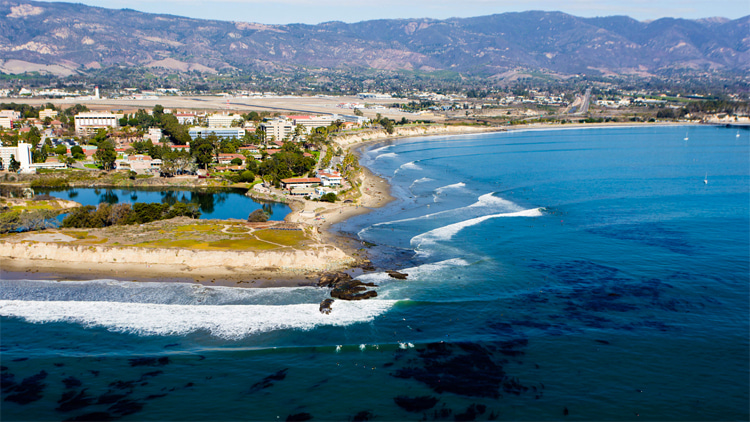Diffraction is a sudden change in the direction and intensity of waves after passing by a coastal feature or offshore obstruction.
The obstacle will block a portion of the wave's energy, forcing it to spread into the sheltered area behind the obstruction.
For example, if a west or southwest swell reaches a south-facing surf spot with a curved shoreline, the energy of the waves will diffract - or bend - toward the protected or hidden area of the coastline.
There are several surf breaks around the world where diffraction results in spectacular, perfect-peeling waves breaking down the line for 100, 200, 300 yards, or more.
In other words, it's not always bad to surf at a beach that is not directly facing the prevailing swell angle. Diffraction can actually transform a wave-protected shoreline into a world-class point break.
The waves resulting from diffraction are always weaker and smaller than before hitting the obstacle and bending.
But, oftentimes and during winter, filtering energy could be a good thing, especially with powerful long-period groundswells.
"For instance, a big northwest swell hitting the California coast would pound the west-facing areas, but south-facing breaks, like the Santa Cruz region, would be cleaner yet smaller from diffracted energy that wrapped in," explains Nathan Todd Cool, author of "The WetSand WaveCast Guide to Surf Forecasting."

A Sensitive Surf Forecasting Variable
The behavior of diffraction and the impact it has on surf breaks cannot be calculated with high precision.
Several variables - like shoaling and refraction, tides, winds, and other bathymetric factors - can reduce the accuracy of surf forecasts for highly diffraction-influenced surf spots.
However, a good knowledge of the break can help improve the prediction.
The difference between diffraction and refraction is that refraction is the bending of a wave as it travels and propagates over different depths - diffraction needs an obstacle to force the bending of the wave.
In a refractive process, the part of a wavefront that propagates over shallow water will slow down, and the part in deep water will keep going at the same original speed.
In other words, diffraction provides natural protection from extreme storm-generated waves and should be taken into consideration by engineers when building breakwaters.
"Breakwaters reduce the wave height at the shore in two ways," underlines Fredric Raichlen, author of "Waves."
"First, only a fraction of the seaward wave energy is transmitted through the gap. Second, the transmitted energy spreads laterally in the lee of the breakwater because of diffraction."
Diffraction in an Island
Headlands are not the only example where diffraction can be observed clearly and in action.
"Imagine that a train of waves moving across the ocean suddenly encounters a steep-sided island rising from the depths," notes Willard Bascom and Kim McCoy, author of "Waves and Beaches."
"Anyone would expect the waves to be lower on the lee side, and a boat seeking calmer water would run in behind the island."
"But exactly where would the boat stop rolling as it moved into more protected water? Would the island cast a clear 'wave shadow' in which the water is perfectly calm?"
No. Waves would pass the island, diffract, and some of their energy would propagate sidewise into the sheltered area of the island.
In other words, as they pass around the edge of an obstacle, waves tend to spread out their energy in a circular arc into undisturbed waters and lose intensity.
The wavefront that didn't encounter an obstacle will proceed at its normal speed.
However, it's important to stress that protection from diffracted waves is related to both the shape of the obstacle and the length of the incident waves.
"The reduction in wave height caused by diffraction depends on the distance shoreward of the island to the location of interest measured in wavelengths," concludes Raichlen.
Interestingly, diffraction is a phenomenon that also occurs in sound and optics.
